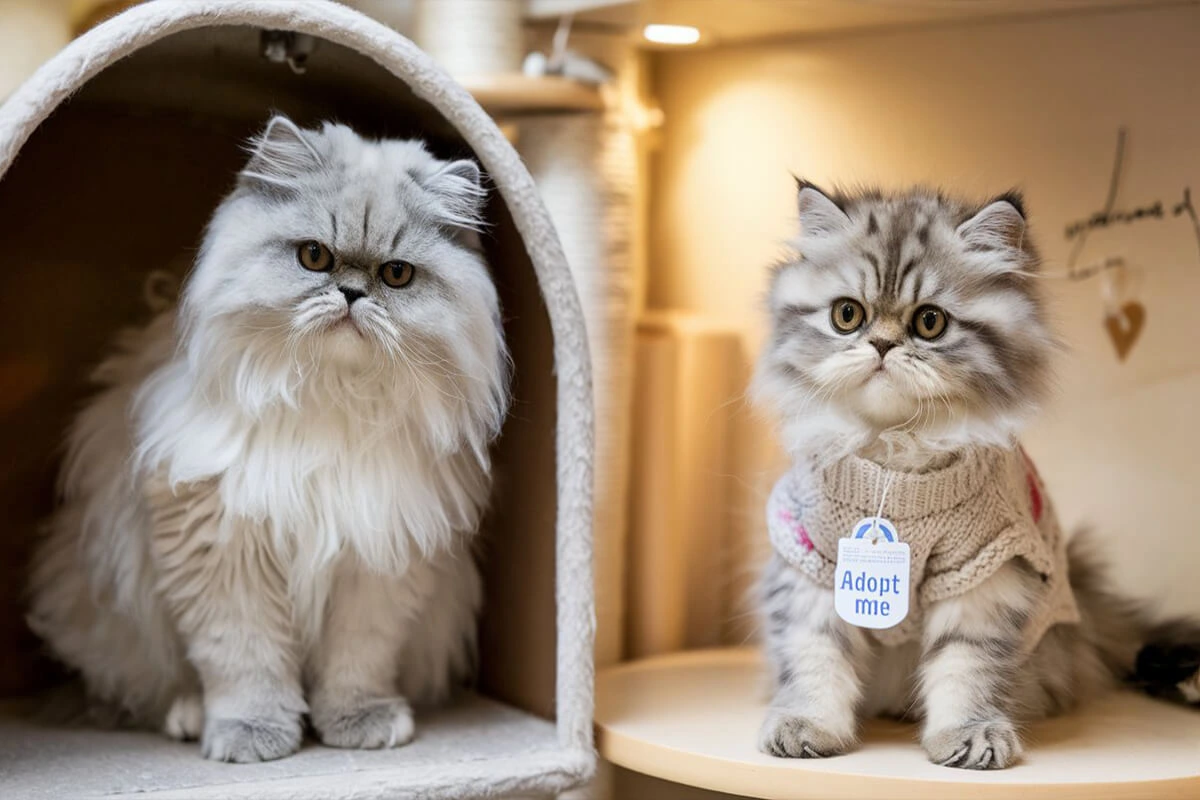Persian cat price varies widely, making it essential for potential owners to understand the full cost of owning this elegant breed. Persian cats are one of the most sought-after breeds due to their luxurious coats, round faces, and affectionate personalities. However, their beauty comes with a price—both in terms of initial purchase costs and long-term maintenance expenses.
Owning a Persian cat goes beyond just the upfront cost of buying a kitten. This breed requires special care, including regular grooming, high-quality food, and frequent vet visits. Without proper planning, unexpected expenses can add up quickly. Before bringing home a Persian cat, you need to understand the true cost of ownership and prepare for both the financial and time commitments involved.
In this guide, we will break down the Persian cat price, covering everything from the initial purchase cost to long-term expenses like grooming, food, and veterinary care. Whether you plan to buy from a breeder or adopt from a shelter, this article will help you make an informed decision about whether a Persian cat is the right fit for your budget and lifestyle.
How Much Does a Persian Cat Cost?
Price Range of Persian Kittens vs. Adult Cats
Persian kittens typically cost more than adult cats due to their high demand. The price of a Persian kitten can range from $500 to $5,000 depending on factors like pedigree, breeder reputation, and coat quality. Show-quality kittens from champion bloodlines usually cost the most, while pet-quality kittens with minor imperfections may fall on the lower end of the price spectrum.
Adult Persian cats often cost less than kittens. Many breeders and shelters offer retired breeding or show cats for adoption at a lower price, usually between $300 and $1,500. These cats may already be spayed or neutered, vaccinated, and socialized, which reduces initial veterinary costs. If you prefer a more affordable option, adopting an adult Persian cat can be a great way to enjoy the breed without the high price tag of a kitten.
Factors Affecting the Cost of a Persian Cat
Several factors influence the Persian cat price, making it important to understand what drives the cost up or down.
- Breeder Reputation & Certification: Reputable breeders who follow ethical breeding practices and register their cats with organizations like TICA (The International Cat Association) or CFA (Cat Fanciers’ Association) charge higher prices. These breeders provide health guarantees, genetic testing, and proper socialization for their kittens. Backyard breeders or pet stores often sell Persian cats at lower prices, but they may lack health screenings and proper care.
- Pedigree & Bloodline: Persian cats from champion bloodlines cost significantly more, especially if they are show-quality. Cats bred for competitions have specific facial structures, coat textures, and colors that meet breed standards. Their lineage adds prestige and value, which raises the price.
- Coat Color & Type: Certain Persian cat colors, such as rare chinchilla, golden, or bi-color coats, can cost more due to their rarity. Standard colors like white, black, and blue tend to be more affordable. Additionally, different Persian breeds, such as Doll Face, Peke Face, Himalayan, and Exotic Shorthair, have different price ranges based on demand and rarity.
- Location & Availability: Persian cat prices vary by region. Areas with more reputable breeders tend to have higher prices, while locations with fewer breeders may require additional shipping fees.
Price Comparison in Different Regions (USA, UK, India, Australia)
Persian cat prices fluctuate based on the country and availability of breeders. Here’s a general comparison:
- USA: Persian kittens cost between $1,000 and $5,000. Show-quality kittens from CFA-registered breeders can reach the higher end, while pet-quality kittens from smaller breeders or shelters may be more affordable.
- UK: Persian cats in the UK typically range from £500 to £2,500. Kittens from GCCF (Governing Council of the Cat Fancy)-registered breeders tend to be more expensive.
- India: Persian cats are highly popular in India, with prices ranging from ₹15,000 to ₹1,00,000 ($180–$1,200 USD). Quality, breed purity, and breeder reputation greatly influence the cost, with metro cities having higher prices.
- Australia: Persian cats in Australia range from AUD 1,000 to AUD 4,000. The availability of breeders and import costs contribute to price variations.
Understanding these price differences helps potential owners budget accordingly based on their location. If you plan to import a Persian cat from another country, consider additional expenses like shipping, vaccinations, and quarantine requirements.
Initial Costs of Owning a Persian Cat
Buying from Breeders vs. Adopting from Shelters (TICA, CFA-Certified Breeders)
When deciding where to get a Persian cat, you can either buy from a reputable breeder or adopt from a shelter or rescue organization. Each option comes with different costs and benefits.
- Buying from a Breeder:
Reputable breeders who are TICA (The International Cat Association) or CFA (Cat Fanciers’ Association) certified follow strict ethical breeding practices. They provide Persian kittens with proper vaccinations, genetic testing, and a well-documented lineage. Breeders typically charge anywhere from $1,000 to $5,000, depending on the kitten’s pedigree, coat color, and quality. Show-quality Persian cats cost more due to their superior genetics and breed standards.When buying from a breeder, always ask for health certificates, genetic test results, and registration papers. Responsible breeders offer health guarantees and raise kittens in a nurturing environment, ensuring they are well-socialized before going to their new homes. - Adopting from a Shelter or Rescue Organization:
Many Persian cats end up in shelters or breed-specific rescues due to owner surrenders. Adoption fees range from $100 to $500, making this a much more affordable option. Shelters often include spaying/neutering, vaccinations, and basic health checks in the adoption fee, saving you additional upfront costs. Organizations like Petfinder, Persian Cat Rescue, and breed-specific rescues frequently have Persians available for adoption.While adoption is more affordable, finding a Persian kitten in a shelter can be rare. Most available Persian cats are adults or seniors, but they still make wonderful pets. If you’re open to adopting an older cat, you can save money and provide a loving home to a cat in need.
Cost of Essential Supplies (Litter Box, Bed, Carrier, Scratching Post)
Before bringing a Persian cat home, you need to invest in essential supplies to ensure a comfortable and safe environment. These initial costs can add up, so budgeting properly is important.
- Litter Box & Litter:
A good covered or large litter box works best for Persian cats since they have long fur that can trap litter. Expect to spend $30 to $100 for a high-quality litter box. Monthly litter costs vary depending on the type, with clumping clay or silica gel litter costing between $15 and $30 per month. - Bed & Cat Tree:
Persian cats love lounging in soft, cozy spots. A plush cat bed costs between $20 and $80, while a cat tree or perch ranges from $50 to $200, providing them with a comfortable space to relax. - Carrier & Travel Accessories:
A sturdy pet carrier is necessary for vet visits and travel. A well-ventilated hard-shell carrier costs around $40 to $100, while soft-sided carriers are slightly cheaper. - Scratching Post & Toys:
Persian cats need a scratching post to prevent furniture damage. A high-quality post costs between $25 and $80. Interactive toys, feather wands, and catnip toys keep them entertained, with a small monthly toy budget of $10 to $30.
Overall, initial supplies can cost anywhere from $200 to $500, depending on the quality and brand of the products you choose.
First-Time Vet Visits, Vaccinations, and Microchipping Costs
Persian cats require several veterinary procedures during their first year to ensure their health and prevent common diseases.
- Initial Vet Examination:
Within the first week of bringing your Persian cat home, schedule a check-up with a vet. A routine wellness exam costs between $50 and $100, depending on the clinic. - Vaccinations:
Kittens require a series of core vaccinations to protect against feline diseases like feline viral rhinotracheitis, calicivirus, and panleukopenia (FVRCP). They also need rabies shots, which are mandatory in most regions.- FVRCP vaccine: $20–$40 per dose (3 doses needed)
- Rabies vaccine: $15–$25
- Leukemia vaccine (optional for indoor cats): $25–$50
- Deworming & Flea Prevention:
Persian kittens may need deworming treatments to prevent intestinal parasites, which cost $10–$30 per treatment. Monthly flea and tick prevention costs $15–$50, depending on the brand. - Microchipping:
A microchip helps identify your cat if they ever get lost. The procedure costs $30 to $60, and many shelters include it in the adoption fee. - Spaying/Neutering:
If your Persian kitten isn’t already spayed or neutered, expect to pay $100 to $300 for the procedure. Spaying (for females) generally costs more than neutering (for males).
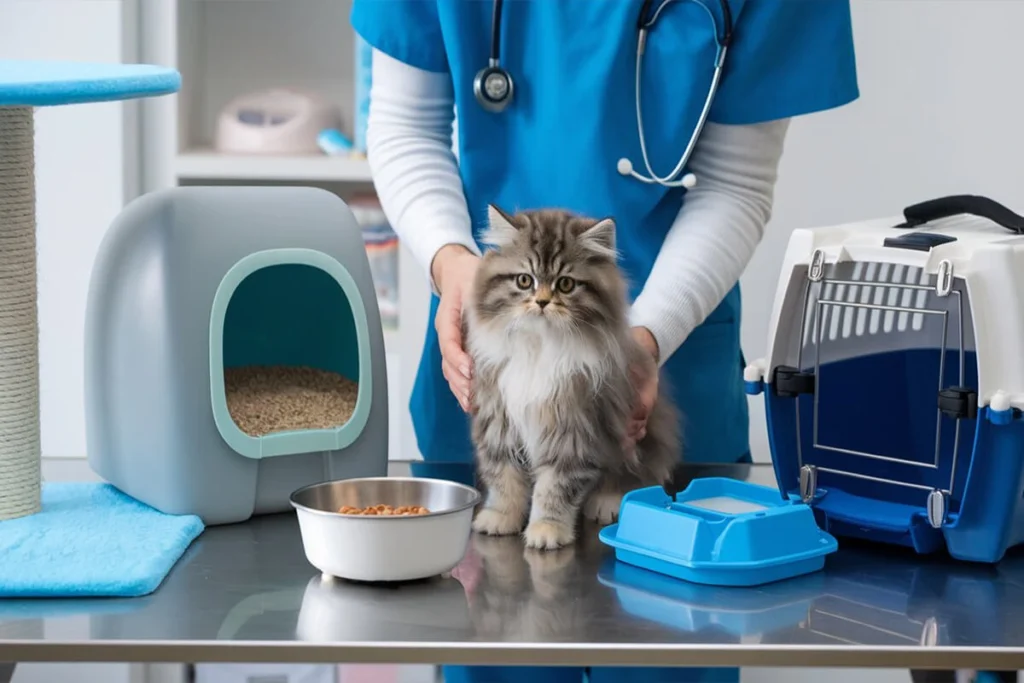
In total, first-year vet costs range from $200 to $600, depending on your cat’s health and whether vaccinations and procedures are already included in the adoption or breeder package.
By preparing for these initial expenses, you can ensure a smooth transition for your Persian cat into their new home while keeping them healthy and happy.
Ongoing Persian Cat Maintenance Costs
Grooming Expenses
Persian cats require extensive grooming to maintain their long, luxurious coats and overall hygiene. Unlike short-haired breeds, their thick fur tangles and mats easily, making regular grooming a necessity rather than a luxury.
- Professional Grooming Costs:
Many Persian cat owners choose professional groomers to handle their cat’s coat maintenance. A full grooming session, including a bath, brushing, nail trimming, ear cleaning, and sanitary trim, costs between $50 and $100 per session. If you prefer a lion cut (a shaved body with a fluffy mane), groomers charge around $80 to $150 per session. Most Persian cats need professional grooming every 6 to 8 weeks, adding up to $400 to $1,000 per year. - At-Home Grooming Costs:
Grooming at home reduces costs, but you need to invest in high-quality grooming tools:- Wide-tooth metal comb: $10–$25
- Soft-bristle brush: $15–$30
- Cat-friendly shampoo & conditioner: $15–$40
- Nail clippers & ear cleaner: $10–$25 each
- Additional Grooming Needs:
- Eye Cleaning: Persian cats often have watery eyes due to their flat faces. Tear stain removers and wipes cost around $10 to $20 per month.
- Dental Care: Regular brushing with cat-friendly toothpaste ($10–$20) or dental treats ($5–$15 per month) helps prevent dental diseases.
By choosing between professional and at-home grooming, you can control expenses while keeping your Persian cat’s coat and hygiene in top condition.
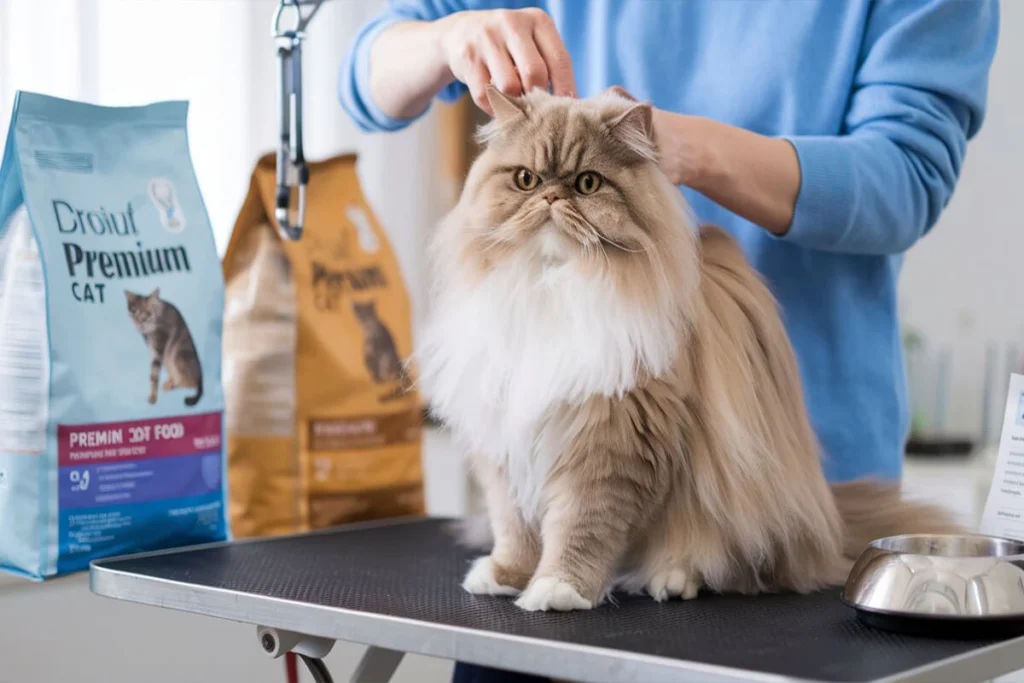
Food Costs
Persian cats need high-quality food to maintain their skin, coat, and overall health. Their flat faces make them prone to eating difficulties, so they benefit from specially shaped kibble or soft food options.
- Dry Food (Kibble):
Premium Persian cat food brands like Royal Canin Persian, Blue Buffalo, and Wellness CORE offer nutrient-rich dry food. Expect to pay $20 to $60 per month, depending on the brand and portion size. - Wet Food (Canned):
Many Persian cats prefer wet food because of its moisture content and easy consumption. High-quality canned food costs between $30 and $80 per month. - Raw or Fresh Diets:
Some owners opt for raw or home-cooked meals, which require careful balance to provide proper nutrition. A raw diet can cost $50 to $150 per month, depending on the ingredients used. - Treats & Supplements:
Occasional treats and omega-3 supplements for skin and coat health add $10 to $30 per month to your budget. - Total Monthly Food Cost:
- Budget brands: $30–$50 per month
- Mid-range brands: $50–$100 per month
- Premium or raw diet: $100–$150 per month
Choosing the right diet ensures your Persian cat stays healthy while minimizing the risk of digestive issues, hairballs, and obesity.
Veterinary Care
Persian cats require routine vet visits and specialized healthcare due to their flat faces (brachycephalic features), long coats, and genetic predispositions to certain health issues.
- Annual Checkups & Routine Care:
A regular vet visit, including a physical exam, vaccinations, and parasite prevention, costs between $100 and $300 per year. - Vaccinations & Preventative Care:
- Core vaccines (FVRCP, rabies): $50–$100 per year
- Flea, tick, and heartworm prevention: $10–$30 per month
- Dental cleaning (recommended yearly): $200–$600
- Common Health Issues & Potential Costs:
Persian cats are prone to several breed-specific health issues, which can lead to high veterinary expenses:- Respiratory problems (due to flat faces): Treatments cost $200–$1,500, depending on severity.
- Polycystic Kidney Disease (PKD): Treatment and management cost $500–$3,000.
- Eye issues (excessive tearing, infections): Vet visits and medications range from $100–$500 per year.
- Heart disease: Treatment, tests, and medications cost $500–$2,000 per year.
- Emergency Vet Visits & Surgery Costs:
If your Persian cat faces a sudden illness or accident, emergency vet bills can reach thousands of dollars.- Minor emergencies: $200–$1,000
- Major surgeries: $1,500–$5,000
- Pet Insurance:
Many Persian cat owners invest in pet insurance to help cover vet expenses. Plans range from $20 to $80 per month, depending on coverage. A comprehensive insurance plan can significantly reduce the financial burden of unexpected medical costs.
Total Estimated Veterinary Costs Per Year:
- Routine care & vaccinations: $200–$600
- Dental cleaning: $200–$600
- Emergency care or major health treatments: $500–$3,000 (if needed)
- Pet insurance (optional): $240–$960 per year
By staying proactive with veterinary care, you can prevent serious health issues and ensure a longer, healthier life for your Persian cat.
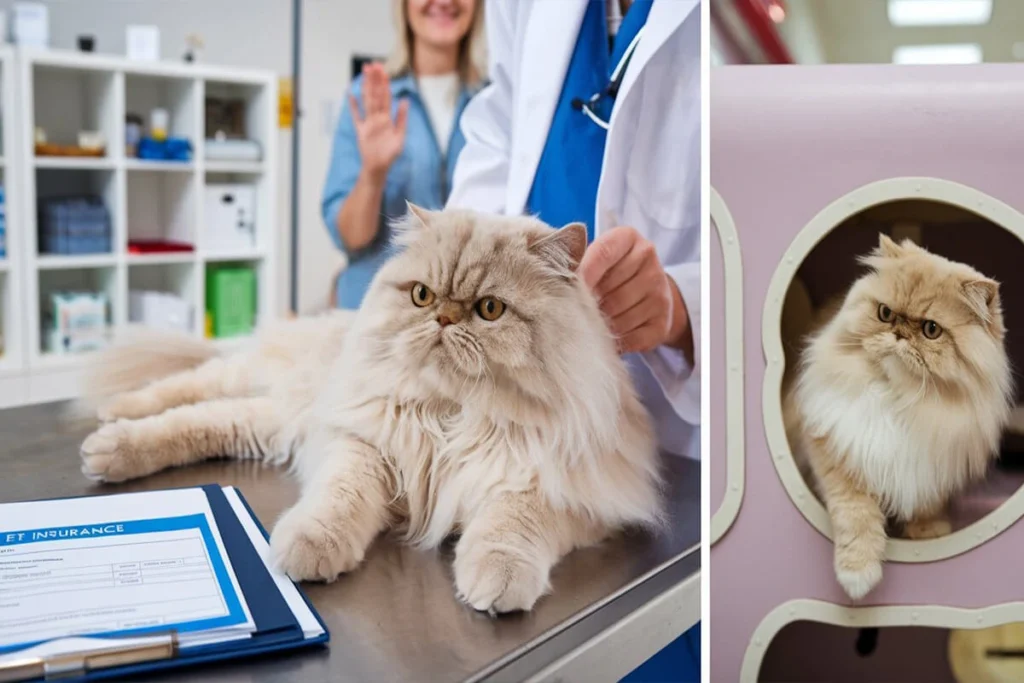
Hidden & Long-Term Expenses of Persian Cat Ownership
Pet Insurance
Owning a Persian cat comes with potential health risks, making pet insurance a valuable investment. Since the Persian cat price includes not only the initial cost but also long-term care expenses, planning for medical costs is essential. Persian cats are prone to genetic and breed-specific health issues, such as polycystic kidney disease (PKD), respiratory problems, and dental issues. Unexpected vet bills can add up quickly, making pet insurance a smart financial choice for owners who want to manage expenses effectively.
Pet insurance helps offset costs by covering routine checkups, emergency visits, and long-term treatments, ensuring Persian cats receive the best possible care without burdening owners with high medical bills. Since Persian cat prices vary based on breeder reputation, location, and pedigree, investing in pet insurance protects against unexpected healthcare costs, allowing owners to enjoy their luxurious, affectionate Persian companion without financial stress..
Types of Pet Insurance Plans
Many pet insurance companies provide different types of protection for your pets:
- Accident-Only Plans: These cover unexpected injuries, such as fractures or poisoning. They typically cost $15 to $30 per month but do not cover illnesses.
- Accident & Illness Plans: These cover vet visits, surgeries, diagnostic tests, and medications for accidents and common illnesses. Expect to pay $30 to $80 per month depending on the provider and coverage level.
- Comprehensive Plans: These offer full coverage, including accidents, illnesses, hereditary conditions, wellness checkups, dental care, and vaccinations. Premiums range from $50 to $100 per month but provide the most financial protection.
Factors Affecting Persian Cat Insurance Costs
Several factors influence monthly insurance premiums:
- Age of the cat: Kittens have lower premiums, while older cats cost more to insure due to increased health risks.
- Pre-existing conditions: Insurance does not cover conditions diagnosed before the policy starts, so early enrollment is recommended.
- Location: Vet costs vary by region, impacting insurance prices.
- Deductibles & Reimbursement Rates: Plans with lower deductibles and higher reimbursement percentages have higher premiums but reduce out-of-pocket expenses.
Estimated Yearly Insurance Costs
- Basic accident coverage: $180–$360 per year
- Accident & illness coverage: $360–$960 per year
- Comprehensive coverage: $600–$1,200 per year
A well-chosen pet insurance plan can save thousands of dollars in medical expenses over a Persian cat’s lifetime, ensuring they receive the best care without financial strain.
Common Health Issues in Persian Cats and Their Treatment Costs
Persian cats have unique health challenges due to their flat faces, long coats, and genetic predispositions. Recognizing potential health problems early helps owners prepare for treatment costs.
1. Brachycephalic Airway Syndrome (Breathing Problems)
Persian cats have short nasal passages and flat faces, making breathing difficult. Symptoms include snoring, labored breathing, and overheating.
- Treatment: Mild cases require humidifiers and lifestyle adjustments ($50–$200), while severe cases need corrective surgery ($1,500–$3,000).
2. Polycystic Kidney Disease (PKD)
PKD is a genetic disorder that causes cysts to form in the kidneys, leading to kidney failure. Persian cats are at high risk.
- Diagnosis: Ultrasound or genetic testing ($300–$500).
- Treatment: No cure exists, but medications and special diets ($500–$2,000 per year) help manage symptoms.
3. Eye Problems (Excessive Tearing & Infections)
Persians have shallow eye sockets, leading to excessive tearing, tear staining, and infections.
- Treatment: Daily eye cleaning with wipes ($10–$20 per month). Antibiotics for infections cost $50–$200 per treatment.
4. Dental Issues (Tooth Crowding & Gum Disease)
Persian cats’ flat faces cause crowded teeth, leading to dental disease if not managed.
- Treatment: Regular brushing and dental treats ($10–$30 per month). Professional dental cleaning costs $200–$600 per year.
5. Heart Disease (Hypertrophic Cardiomyopathy – HCM)
HCM is a common heart condition in Persian cats that thickens the heart muscle.
- Diagnosis: Echocardiogram & X-rays ($500–$1,200).
- Treatment: Lifelong medications ($50–$150 per month) and vet monitoring ($300–$600 per year).
6. Skin & Coat Problems
Persian cats’ long fur can trap dirt and moisture, leading to fungal infections and matting.
- Treatment: Regular grooming ($400–$1,000 per year) and antifungal treatments ($50–$200 per occurrence).
Estimated Annual Veterinary Costs for Common Persian Cat Health Issues:
- Minor treatments & checkups: $200–$500
- Chronic condition management: $500–$3,000
- Emergency surgeries & advanced treatments: $1,500–$5,000
Proper preventative care and pet insurance help reduce financial strain while ensuring Persian cats receive necessary treatments.
Boarding or Pet-Sitting Costs When Traveling
Persian cats require special care when their owners travel. Whether you choose a boarding facility or a pet sitter, planning for these expenses is essential.
Boarding Facilities (Catteries & Pet Hotels)
Boarding facilities offer secure, supervised care while you’re away. Many provide private suites, playtime, and grooming services for Persian cats.
- Standard boarding: $20–$50 per night
- Luxury pet hotels: $50–$100 per night (includes extra playtime, webcam access, and premium meals)
- Medical boarding (for cats with health conditions): $50–$150 per night
Pet Sitting (In-Home Care)
Hiring a pet sitter allows your Persian cat to stay in a familiar home environment, reducing stress.
- Drop-in visits (1–2 times per day): $15–$40 per visit
- Overnight stays: $50–$100 per night
- Live-in pet sitters (extended care): $500–$1,500 per week
Many Persian cat owners prefer pet sitters because they provide personalized attention and reduce anxiety for the cat.
Additional Travel Costs
If you plan to bring your Persian cat on a trip, you’ll need:
- Airline pet fees: $100–$500 per flight (depending on airline policies)
- Pet travel carrier: $40–$150
- Health certificates & vaccinations for travel: $50–$200
Total Estimated Cost for Cat Care During Travel:
- Short trip (weekend): $60–$300
- Long trip (1–2 weeks): $300–$1,500
- Luxury or medical care options: $500–$3,000
By planning for boarding or pet-sitting costs, you ensure your Persian cat remains well cared for while you travel, minimizing stress for both you and your pet.
Saving Money While Owning a Persian Cat
Tips for Finding Reputable but Affordable Breeders
Finding a Persian cat at a reasonable price requires careful research to ensure the kitten comes from a healthy and ethical breeding environment. Persian cats are prone to genetic health issues, so working with a reputable breeder prevents costly medical problems later. However, Persian cat prices can vary significantly based on the breeder’s reputation, location, and the kitten’s pedigree.
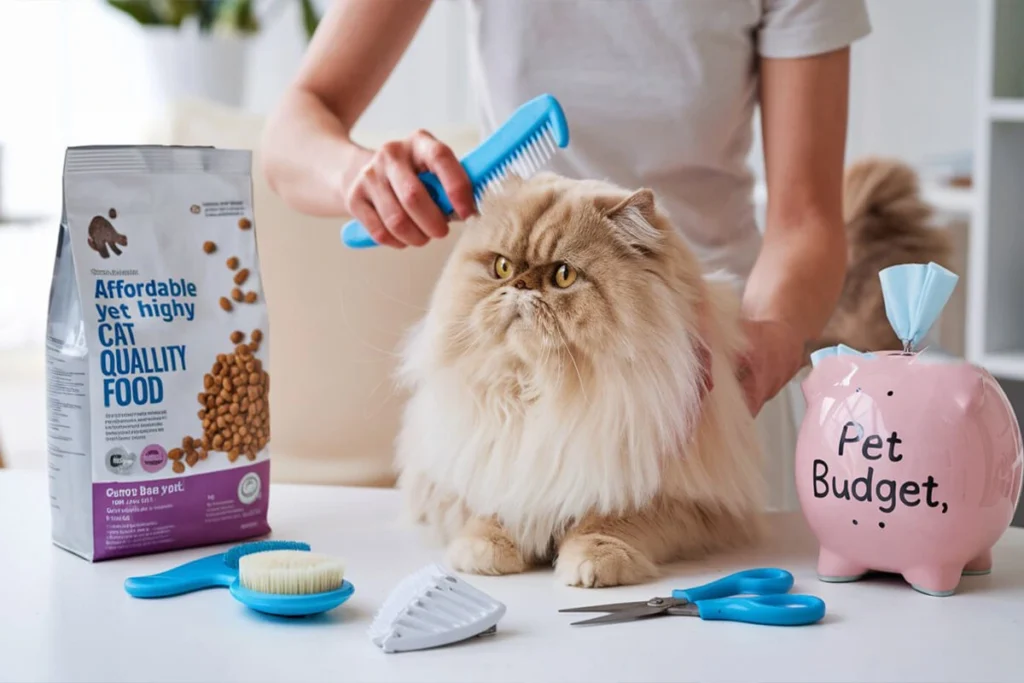
1. Look for CFA & TICA-Certified Breeders
Reputable breeders follow Cat Fanciers’ Association (CFA) and The International Cat Association (TICA) standards to ensure ethical breeding and genetic health. While the Persian cat price from certified breeders may be higher, these breeders provide kittens with vaccinations, health guarantees, and socialization training.
- Visit CFA and TICA websites to browse registered breeders.
- Compare the Persian cat price from multiple breeders to avoid overpaying.
- Ask for health records, including PKD (polycystic kidney disease) screening.
2. Compare Persian Cat Prices by Quality & Region
The Persian cat price depends on coat color, bloodline, and location. A pet-quality Persian kitten (non-show standard) costs between $500 and $1,500, while a show-quality Persian can reach $5,000 or more.
- USA: $1,000–$3,000 (higher for rare colors).
- UK: £500–£2,000.
- India: ₹30,000–₹80,000.
- Australia: AUD 1,000–3,500.
Check regional breeders and shelters to find a Persian cat at a lower price. Some breeders offer discounts on older Persian cats or retired breeding cats, which can save money.
3. Adopt from Shelters & Breed-Specific Rescues
Adoption provides an affordable way to own a Persian cat while supporting rescue efforts. Many Persian cats in shelters need new homes due to previous owners being unable to manage their grooming and care needs.
- Adoption fees typically range from $100 to $500.
- Some Persian cat rescues include Purebred Cat Rescue and local animal shelters.
- Adoption fees often include vaccinations, microchipping, and spaying/neutering, which reduces the Persian cat’s overall cost.
By choosing a reputable breeder or adoption center, you ensure your Persian cat is healthy without overpaying for unnecessary expenses.
DIY Grooming and Home Care to Cut Costs
The Persian cat price doesn’t end with the initial purchase—ongoing grooming expenses can add up quickly. Since Persian cats require frequent grooming, professional grooming services cost between $50 and $100 per session. Learning DIY grooming techniques saves money while keeping your Persian cat’s coat healthy.
1. Invest in Essential Grooming Tools
Instead of paying for grooming appointments, buy high-quality grooming tools for home use:
- Metal wide-tooth comb: $10–$25 (prevents mats).
- Bristle brush: $15–$30 (smooths the coat).
- Cat-safe clippers & trimmers: $30–$100 (for sanitary trims).
- Tear stain remover wipes: $10–$20 per month (reduces eye discharge).
With these tools, you can maintain your Persian cat’s coat and avoid unnecessary grooming costs.
2. Follow a Daily Grooming Routine
Persian cats have long, thick fur prone to matting. Neglecting grooming leads to costly vet visits or professional dematting services. Establishing a daily routine helps manage their coat without extra expenses:
- Brush daily to prevent painful tangles and hairballs.
- Bathe monthly using a cat-safe shampoo ($15–$40 per bottle).
- Trim nails every 2–3 weeks to prevent scratches and furniture damage.
3. Reduce Tear Staining & Facial Cleaning Costs
Due to their flat faces, Persian cats experience excessive tearing, leading to stained fur and eye infections. Instead of expensive tear stain removers, try:
- Diluted saline solution ($5 per bottle) for gentle cleaning.
- Soft cotton pads ($3–$10 per pack) to wipe excess tears.
By handling grooming at home, Persian cat owners cut costs significantly while ensuring their pet stays clean, healthy, and comfortable.
Choosing Cost-Effective Yet High-Quality Food and Vet Care Options
The Persian cat price goes beyond the purchase cost, as feeding and medical care require long-term financial planning. Persian cats have sensitive digestive systems, specific dietary needs, and require regular vet checkups. Choosing cost-effective food and vet care ensures your Persian cat remains healthy without excessive expenses.
1. Selecting Affordable, High-Quality Cat Food
A Persian cat’s diet directly affects coat health, digestion, and overall well-being. Many premium cat food brands are expensive, but nutritional quality doesn’t always depend on price. Look for:
- High-protein, grain-free dry food ($30–$60 per bag).
- Wet food with real meat ingredients ($1–$3 per can).
- Budget-friendly brands with premium nutrition (Royal Canin Persian, Blue Buffalo, Hill’s Science Diet).
Buying in bulk or subscribing to pet food delivery services saves 10–20% per purchase.
2. Finding Affordable Veterinary Care
Persian cats require routine checkups, vaccinations, and emergency care. Vet expenses can range from $200 to $1,000 annually, but owners can reduce costs by:
- Visiting low-cost veterinary clinics (local shelters and universities offer affordable services).
- Using pet wellness plans (some vets provide discounted packages for annual vaccinations and exams).
- Comparing prices at multiple vet clinics before committing to one provider.
Preventative care, such as regular dental cleaning and weight management, minimizes long-term health risks and expensive medical treatments.
3. Consider Pet Insurance for Persian Cats
Since Persian cats are prone to health issues like kidney disease, breathing problems, and dental issues, unexpected vet bills can exceed $3,000. Pet insurance reduces financial burden by covering:
- Emergency treatments & surgeries ($1,500–$5,000).
- Chronic condition management (hypertrophic cardiomyopathy, PKD).
- Routine care & vaccinations ($50–$300 per year).
Choosing a pet insurance plan ($30–$80 per month) protects against sudden medical expenses, making Persian cat ownership more manageable in the long run.
Conclusion
Owning a Persian cat brings joy and elegance into any home, but understanding the true Persian cat price goes beyond the initial cost. From buying or adopting to long-term expenses like grooming, food, and vet care, every aspect of Persian cat price requires careful financial planning.
Choosing the right breeder or adoption center ensures a healthy Persian cat while keeping costs manageable. Reputable CFA or TICA-certified breeders charge more upfront, but they provide health guarantees and pedigree papers, which help avoid costly medical issues later. Adoption offers a more affordable alternative, with many Persian cats needing loving homes at a fraction of the cost.
Grooming a Persian cat requires daily maintenance, and professional grooming services add up quickly. Owners can save hundreds of dollars annually by investing in grooming tools and learning DIY grooming techniques at home. Regular brushing, tear stain cleaning, and occasional bathing keep their luxurious coats in top condition without expensive salon visits.
Feeding a Persian cat also plays a major role in long-term Persian cat price considerations. While premium cat food brands offer balanced nutrition, owners can find cost-effective yet high-quality food options by comparing brands and buying in bulk. Preventative veterinary care, wellness plans, and pet insurance help manage unexpected health issues and avoid hefty medical bills.
By making smart financial choices, Persian cat owners can enjoy the companionship of this elegant breed without overspending. Proper planning ensures a happy, healthy, and well-maintained Persian cat, allowing cat lovers to experience the beauty of this breed without financial strain.
Discover The Grey Persian Cat Breed From Here.
Discover More Pets and Breeds From Here
You Can Find Good stuff for your Furry Pet on Pet MD Official
